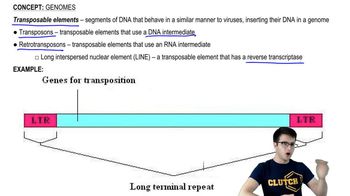Table of contents
- 1. Introduction to Biology2h 42m
- 2. Chemistry3h 40m
- 3. Water1h 26m
- 4. Biomolecules2h 23m
- 5. Cell Components2h 26m
- 6. The Membrane2h 31m
- 7. Energy and Metabolism2h 0m
- 8. Respiration2h 40m
- 9. Photosynthesis2h 49m
- 10. Cell Signaling59m
- 11. Cell Division2h 47m
- 12. Meiosis2h 0m
- 13. Mendelian Genetics4h 44m
- Introduction to Mendel's Experiments7m
- Genotype vs. Phenotype17m
- Punnett Squares13m
- Mendel's Experiments26m
- Mendel's Laws18m
- Monohybrid Crosses19m
- Test Crosses14m
- Dihybrid Crosses20m
- Punnett Square Probability26m
- Incomplete Dominance vs. Codominance20m
- Epistasis7m
- Non-Mendelian Genetics12m
- Pedigrees6m
- Autosomal Inheritance21m
- Sex-Linked Inheritance43m
- X-Inactivation9m
- 14. DNA Synthesis2h 27m
- 15. Gene Expression3h 20m
- 16. Regulation of Expression3h 31m
- Introduction to Regulation of Gene Expression13m
- Prokaryotic Gene Regulation via Operons27m
- The Lac Operon21m
- Glucose's Impact on Lac Operon25m
- The Trp Operon20m
- Review of the Lac Operon & Trp Operon11m
- Introduction to Eukaryotic Gene Regulation9m
- Eukaryotic Chromatin Modifications16m
- Eukaryotic Transcriptional Control22m
- Eukaryotic Post-Transcriptional Regulation28m
- Eukaryotic Post-Translational Regulation13m
- 17. Viruses37m
- 18. Biotechnology2h 58m
- 19. Genomics17m
- 20. Development1h 5m
- 21. Evolution3h 1m
- 22. Evolution of Populations3h 52m
- 23. Speciation1h 37m
- 24. History of Life on Earth2h 6m
- 25. Phylogeny2h 31m
- 26. Prokaryotes4h 59m
- 27. Protists1h 12m
- 28. Plants1h 22m
- 29. Fungi36m
- 30. Overview of Animals34m
- 31. Invertebrates1h 2m
- 32. Vertebrates50m
- 33. Plant Anatomy1h 3m
- 34. Vascular Plant Transport1h 2m
- 35. Soil37m
- 36. Plant Reproduction47m
- 37. Plant Sensation and Response1h 9m
- 38. Animal Form and Function1h 19m
- 39. Digestive System1h 10m
- 40. Circulatory System1h 57m
- 41. Immune System1h 12m
- 42. Osmoregulation and Excretion50m
- 43. Endocrine System1h 4m
- 44. Animal Reproduction1h 2m
- 45. Nervous System1h 55m
- 46. Sensory Systems46m
- 47. Muscle Systems23m
- 48. Ecology3h 11m
- Introduction to Ecology20m
- Biogeography14m
- Earth's Climate Patterns50m
- Introduction to Terrestrial Biomes10m
- Terrestrial Biomes: Near Equator13m
- Terrestrial Biomes: Temperate Regions10m
- Terrestrial Biomes: Northern Regions15m
- Introduction to Aquatic Biomes27m
- Freshwater Aquatic Biomes14m
- Marine Aquatic Biomes13m
- 49. Animal Behavior28m
- 50. Population Ecology3h 41m
- Introduction to Population Ecology28m
- Population Sampling Methods23m
- Life History12m
- Population Demography17m
- Factors Limiting Population Growth14m
- Introduction to Population Growth Models22m
- Linear Population Growth6m
- Exponential Population Growth29m
- Logistic Population Growth32m
- r/K Selection10m
- The Human Population22m
- 51. Community Ecology2h 46m
- Introduction to Community Ecology2m
- Introduction to Community Interactions9m
- Community Interactions: Competition (-/-)38m
- Community Interactions: Exploitation (+/-)23m
- Community Interactions: Mutualism (+/+) & Commensalism (+/0)9m
- Community Structure35m
- Community Dynamics26m
- Geographic Impact on Communities21m
- 52. Ecosystems2h 36m
- 53. Conservation Biology24m
19. Genomics
Genomes
Problem 1`
Textbook Question
Bioinformatics includes all of the following except
a. Using computer programs to align DNA sequences.
b. Using DNA technology to combine DNA from two different sources in a test tube.
c. Developing computer-based tools for genome analysis.
d. Using mathematical tools to make sense of biological systems.
 Verified step by step guidance
Verified step by step guidance1
Understand the definition of bioinformatics: Bioinformatics is an interdisciplinary field that develops methods and software tools for understanding biological data, particularly when the data sets are large and complex.
Identify the common applications of bioinformatics: These include aligning DNA sequences, developing computer-based tools for genome analysis, and using mathematical tools to interpret biological systems.
Analyze each option: a) Using computer programs to align DNA sequences is a common bioinformatics task. b) Using DNA technology to combine DNA from two different sources is more related to genetic engineering or molecular biology techniques. c) Developing computer-based tools for genome analysis is a core aspect of bioinformatics. d) Using mathematical tools to make sense of biological systems is also a part of bioinformatics.
Determine which option does not fit the typical bioinformatics tasks: Option b involves laboratory techniques rather than computational analysis, which is the focus of bioinformatics.
Conclude that option b is the correct answer as it does not align with the typical tasks associated with bioinformatics, which are more computational and analytical in nature.
 Verified video answer for a similar problem:
Verified video answer for a similar problem:This video solution was recommended by our tutors as helpful for the problem above
Video duration:
1mPlay a video:
Was this helpful?
Key Concepts
Here are the essential concepts you must grasp in order to answer the question correctly.
Bioinformatics
Bioinformatics is an interdisciplinary field that develops and uses computational tools to analyze and interpret biological data. It involves the application of computer science, statistics, and mathematics to understand complex biological systems, such as genomes and protein structures. Key activities include sequence alignment, genome annotation, and data mining.
DNA Sequence Alignment
DNA sequence alignment is a bioinformatics method used to arrange DNA sequences to identify regions of similarity. These alignments help in understanding evolutionary relationships, identifying conserved sequences, and predicting the function of genes. Computer programs are essential for handling the large datasets involved in sequence alignment efficiently.
Recommended video:
Guided course

Introduction to DNA Sequencing
Recombinant DNA Technology
Recombinant DNA technology involves combining DNA from different sources to create new genetic combinations. This process is typically performed in a laboratory setting and is used in various applications, including gene cloning, genetic engineering, and the production of pharmaceuticals. It is distinct from bioinformatics, which focuses on data analysis rather than experimental manipulation.
Recommended video:
Guided course

Map of DNA-Based Technology Lesson

 5:30m
5:30mWatch next
Master Genomes and Genome Evolution with a bite sized video explanation from Jason
Start learningRelated Videos
Related Practice


































